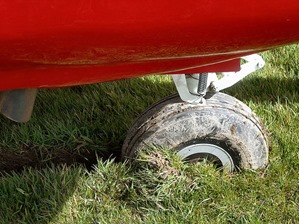Sylvia, the blogger behind the Fear of Landing blog, recently had an unfortunate incident where her aircraft got stuck in the mud on a grass runway alongside the taxiway – something that reminded us of an old query on Ask Flight Instructor about how to transition an aircraft from grass to pavement and vice versa. First, here is what happened to Sylvia:
When I went to turn back onto the taxiway I realised I hadn’t left myself any room to make the turn, I was going to have to enter the grass runway which ran alongside the taxiway. But in that case, I thought, why not just cross the grass and head directly to the asphalt. The radio was silent, no one was coming in, it wasn’t like I was going to be causing any inconvenience.
That turned out to be a bad move due to all the rain the airport had during the previous week and led to the following problem:
Luckily, Sylvia had help readily available who got her plane out of the mud (Warning: Any “handy loop” that is used for tying the plane down may not be intended to be used to tow it according to your aircraft’s handbook).
As for the old Ask Flight Instructor query, Thomas Wester had posted:
What advice is there for transitioning between a paved runway and grass tiedown area (and vice versa)? There is material on taxiing on soft surfaces, but I have not found anything specific to going between hard and soft surfaces.
Bob Watson responded by writing that you need to “keep the nose up in both cases” because the soft surface will likely be slightly lower than the paved surface – meaning going from hard to soft will involve a nose dip and you will want to have “full back-elevator” while taking it slowly and gently to prevent dipping the prop into the dirt. When going from soft to hard, you want to keep full back-elevator and maybe “even give it a little power to get the nose up onto the pavement” (assuming you aren’t stuck in any mud). He also added:
Holding back elevator also helps reduce some of the bouncing, but, depending on the terrain and the airplane, you might need to moderate the back pressure to keep the tail from hitting.
Finally, someone named Brian wrote that you should not take the transition perpendicular, but instead go at a 45 degree angle and keep the yoke in your lap. He then added:
Check the area you plan on transitioning before doing so. A slow taxi past it will suffice, but walking it before hand, when possible, is always best.
In that way, you will avoid potentially embarrassing incidents involving mud.

Leave a Reply